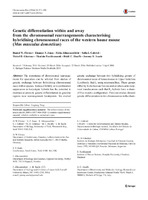| dc.creator | Förster, Daniel W. | |
| dc.creator | Jones, Eleanor P. | |
| dc.creator | Jóhannesdóttir, Fríða | |
| dc.creator | Gabriel, Sofia I. | |
| dc.creator | Giménez, Mabel Dionisia | |
| dc.creator | Panithanarak, Thadsin | |
| dc.creator | Hauffe, Heidi Christine | |
| dc.creator | Searle, Jeremy B. | |
| dc.date.accessioned | 2023-01-31T18:09:16Z | |
| dc.date.available | 2023-01-31T18:09:16Z | |
| dc.date.issued | 2016-04-05 | |
| dc.identifier.citation | Förster, D. W., Jones, E. P., Jóhannesdóttir, F., Gabriel, S. I., Giménez, M. D., Panithanarak, T.,... Searle, J. B. (2016). Genetic differentiation within and away from the chromosomal rearrangements characterising hybridising chromosomal races of the western house mouse (Mus musculus domesticus). Chromosome Research. Berlín, Alemania : Springer; 24 (2), pp. 271-280. | es_AR |
| dc.identifier.issn | 1573-6849 | |
| dc.identifier.other | CCPI-CNyE-A-171 | |
| dc.identifier.other | 9964 | |
| dc.identifier.uri | https://hdl.handle.net/20.500.12219/4477 | |
| dc.description | Fil: Förster, Daniel W. Universidad de York. Departamento de Biología; Reino Unido. | es_AR |
| dc.description | Fil: Förster, Daniel W. Leibniz-Institute for Zoo and Wildlife Research. Department of Evolutionary Genetics; Alemania. | es_AR |
| dc.description | Fil: Jones, Eleanor P. Universidad de York. Departamento de Biología; Reino Unido. | es_AR |
| dc.description | Fil: Jones, Eleanor P. Fera Science; Reino Unido. | es_AR |
| dc.description | Fil: Jóhannesdóttir, Fríða. Universidad de York. Departamento de Biología; Reino Unido. | es_AR |
| dc.description | Fil: Jóhannesdóttir, Fríða. Universidad de Uppsala. Departamento de Ecología y Genética; Suecia. | es_AR |
| dc.description | Fil: Jóhannesdóttir, Fríða. Universidad de Cornell. Departamento de Ecología y Evolución; Estados Unidos. | es_AR |
| dc.description | Fil: Gabriel, Sofia I. Universidad de Aveiro. Centro de Estudio del Ambiente y del Mar; Portugal. | es_AR |
| dc.description | Fil: Gabriel, Sofia I. Universidad de Lisboa. Facultad de Ciencias. Departamento de Biología Animal; Portugal. | es_AR |
| dc.description | Fil: Giménez, Mabel Dionisia. Consejo Nacional de Investigaciones Científicas y Técnicas. Centro Científico Tecnológico (Nordeste). Instituto de Biología Subtropical. Instituto de Biología Subtropical Nodo Posadas; Argentina. | es_AR |
| dc.description | Fil: Giménez, Mabel Dionisia. Universidad Nacional de Misiones. Facultad de Ciencias Exactas, Químicas y Naturales. Instituto de Biología Subtropical. Instituto de Biología Subtropical Nodo Posadas; Argentina. | es_AR |
| dc.description | Fil: Giménez, Mabel Dionisia. Universidad de York. Departamento de Biología; Reino Unido. | es_AR |
| dc.description | Fil: Panithanarak, Thadsin. Universidad de Burapha. Instituto de Ciencias Marinas; Tailandia. | es_AR |
| dc.description | Fil: Hauffe, Heidi Christine. Universidad de York. Departamento de Biología; Reino Unido. | es_AR |
| dc.description | Fil: Hauffe, Heidi Christine. Instituto Agrario San Michele All'adige. Fondazione Edmund Mach. Centro Ricerca e Innovazione. Departamento de Biodiversidad y Ecología Molecular; Italia. | es_AR |
| dc.description | Fil: Searle, Jeremy B. Universidad de York. Departamento de Biología; Reino Unido. | es_AR |
| dc.description | Fil: Searle, Jeremy B. Universidad de Cornell. Departamento de Ecología y Evolución; Estados Unidos. | es_AR |
| dc.description.abstract | The importance of chromosomal rearrangements for speciation can be inferred from studies of genetic exchange between hybridising chromosomal races within species. Reduced fertility or recombination suppression in karyotypic hybrids has the potential to maintain or promote genetic differentiation in genomic regions near rearrangement breakpoints. We studied genetic exchange between two hybridising groups of chromosomal races of house mouse in Upper Valtellina (Lombardy, Italy), using microsatellites. These groups differ by Robertsonian fusions and/or whole-arm reciprocal translocations such that F1 hybrids have a chain-of-five meiotic configuration. Previous studies showed genetic differentiation in two chromosomes in the chain-of-five (10 and 12) close to their centromeres (i.e. the rearrangement breakpoints); we have shown here that the centromeric regions of the other two chromosomes in the chain (2 and 8) are similarly differentiated. The internal chromosomes of the chain (8 and 12) show the greatest differentiation, which may reflect pairing and recombination properties of internal and external elements in a meiotic chain. Importantly, we found that centromeric regions of some non-rearranged chromosomes also showed genetic differentiation between the hybridising groups, indicating a complex interplay between chromosomal rearrangements and other parts of the genome in maintaining or promoting differentiation and potentially driving speciation between chromosomal races. | en |
| dc.format | application/pdf | |
| dc.format.extent | 323.9 KB | |
| dc.language.iso | eng | en |
| dc.publisher | Springer | en |
| dc.relation | info:eu-repo/semantics/altIdentifier/urn/https://link.springer.com/content/pdf/10.1007/s10577-016-9520-1.pdf | |
| dc.rights | info:eu-repo/semantics/openAccess | |
| dc.rights.uri | http://creativecommons.org/licenses/by-nc-sa/4.0/ | |
| dc.subject | Chromosomal hybrid zone | en |
| dc.subject | Introgression | en |
| dc.subject | Microsatellites | en |
| dc.subject | Robertsonian fusión | en |
| dc.subject | Speciation | en |
| dc.title | Genetic differentiation within and away from the chromosomal rearrangements characterising hybridising chromosomal races of the western house mouse (Mus musculus domesticus) | en |
| dc.type | info:eu-repo/semantics/article | |
| dc.type | info:ar-repo/semantics/artículo | |
| dc.type | info:eu-repo/semantics/publishedVersion | |




